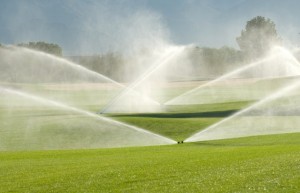Irrigation Irritation
The fairways of Wentworth were, as ever, lush and green for the duration of the BMW PGA Championship, but they weren’t as colourful as Ernie Els’ language on the Saturday evening. If you didn’t read about it, his tirade centred on the lack of water applied to greens, which, according to him, had made them unplayable in places.
 Poor Ernie has come in for a fair amount of stick since helping to redesign this Harry Colt classic and he’s clearly a little sensitive to criticism now. There’s no doubt his lashing out was, in part at least, motivated by a fear that any negative reaction from the other players would reflect badly on him. What damage to his stock as a course designer? Sadly for him, his rant only succeeded in getting more people talking about it.
Poor Ernie has come in for a fair amount of stick since helping to redesign this Harry Colt classic and he’s clearly a little sensitive to criticism now. There’s no doubt his lashing out was, in part at least, motivated by a fear that any negative reaction from the other players would reflect badly on him. What damage to his stock as a course designer? Sadly for him, his rant only succeeded in getting more people talking about it.
But whether he was right or wrong about the watering isn’t my point here (and it didn’t seem to bother Luke Donald much either). What I want to talk about is expectation.
Here in the UK we’ve had a (late and short) spell of glorious weather. Despite all that spring rain, it won’t take long for courses to dry out and suddenly clubs are faced with the stresses of how much and how often they should water the course. There’s much to consider – cost, value, return on investment, service to members, the wider environment and even hosepipe bans. I’ll leave the irrigation advice to those with the expertise in such matters and instead just make a plea for your consideration: don’t expect too much.
 We’re lucky to live in an age where even fairways get watered at many clubs. As is always the case, such improvements just serve to raise expectations (Ernie) of how a course should be presented in the summer months. And to be honest, the pros’ expectations are the most ludicrously high of all; they now play a tour where, with the exception of perhaps the Open and US Open, most other weeks deliver the same condition of course and colour of blue sky, and if it isn’t like that, they throw their toys. Where is it written that tour professionals must always play in “perfect” conditions?
We’re lucky to live in an age where even fairways get watered at many clubs. As is always the case, such improvements just serve to raise expectations (Ernie) of how a course should be presented in the summer months. And to be honest, the pros’ expectations are the most ludicrously high of all; they now play a tour where, with the exception of perhaps the Open and US Open, most other weeks deliver the same condition of course and colour of blue sky, and if it isn’t like that, they throw their toys. Where is it written that tour professionals must always play in “perfect” conditions?
For us mere mortals, come June, July and August, do we really need to demand emerald green fairways and soft receptive greens? Can’t we embrace these months rather than moan about them and enjoy the ego boost that comes with driving a ball 350 yards? Personally, I look forward to these months with hard fast greens, bouncy fairways, and a different style of golf altogether. Keep your verdant fairways for the spring and autumn.
 Cast your memory back to The Open at Hoylake in 2006. I doubt there was a blade of green grass on site. If you recall, Tiger Woods navigated his way around the brown links course without ever using a driver; we marvelled at his performance and the tournament was widely acclaimed as being one of the most successful in years. Here was proof that golf doesn’t have to be completely uniform. How boring if it were? Fast running links style golf is a joy to play and a challenge to master. For a few months, this challenge can be presented at our inland courses, too, and we should welcome it with open arms.
Cast your memory back to The Open at Hoylake in 2006. I doubt there was a blade of green grass on site. If you recall, Tiger Woods navigated his way around the brown links course without ever using a driver; we marvelled at his performance and the tournament was widely acclaimed as being one of the most successful in years. Here was proof that golf doesn’t have to be completely uniform. How boring if it were? Fast running links style golf is a joy to play and a challenge to master. For a few months, this challenge can be presented at our inland courses, too, and we should welcome it with open arms.
To my mind, our expectations should quite simply reflect the seasons. In winter we accept that the ball doesn’t fly as far, it plugs, the courses play longer, we’re in danger of getting soaked or freezing to death and it’s a constant grind for the greenkeepers. We also accept that if it’s frosty or covered in snow, there’s not much anyone can do about it. Yet summer rolls around and we don’t seem to grant the greenkeepers the same kind of latitude.
In a dry spell, isn’t it appropriate to expect hard bouncy greens, brown fairways and bare lies? That’s not to say we let courses turn to dust bowls, (after all, a sustained period of hot weather can be just as damaging as frozen ground or flooding) but shouldn’t we relax a little in the face of Mother Nature and celebrate the weather as the only aspect of the game that remains as it always has been?
It’s also worth bearing in mind the cost implications of irrigating a golf course and that for some (without irrigation systems) that option simply isn’t available. And bear in mind that looking like an oasis in a drought won’t help win over those environmentalists who see golf courses as a blight on the Earth.
Of course, I accept there are pressures on most golf clubs to get the course playing well at certain times of the year. The Club Championships, for example, are invariably played in the summer months, and as the showpiece of the golfing calendar, members want to compete over a course in peak of condition. But who says lush is best? Just because a course is firm, bouncy and slightly brown, doesn’t mean it’s in poor condition. Again, think Hoylake 2006.
So, fellow golfers, while Ernie Els might be getting hot under the collar, I suggest the rest of us take a deep breath before venting our frustration at the greenkeeper. It’s not as simple as turning on the tap and we can always allow for a bit more roll.